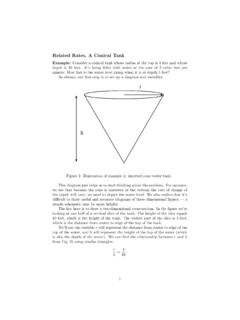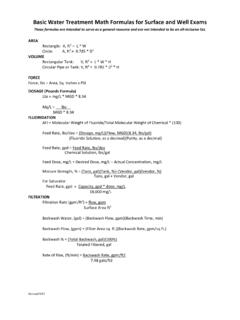Transcription of RESIDENTIAL AIR CLEANERS
1 Indoor Air Quality (IAQ)3rd EditionPortable Air CleanersFurnace and HVAC FiltersEPA 402-F-09-002 | July 2018 | EPA Indoor Environments Division | AIR CLEANERSA Technical AIR CLEANERSFOREWORDThis document was developed by the Environmental Protection Agency (EPA), Office of Radiation and Indoor Air, Indoor Environments Division. It focuses on air CLEANERS for RESIDENTIAL use; it does not address air CLEANERS used in large or commercial structures such as office buildings, schools, large apartment buildings, or public buildings. It should be particularly useful to RESIDENTIAL housing design professionals, public health officials, and indoor air quality professionals. It may serve as a reference for anyone who designs, builds, operates, inspects, maintains, or otherwise works with buildings, heating, ventilating and air conditioning (HVAC) equipment, and/or portable air CLEANERS /sanitizers.
2 This includes home services professionals, builders, remodelers, contractors, and architects. In addition to providing general information about the types of pollutants affected by air CLEANERS , this document discusses the types of air-cleaning devices and technologies available, metrics that can be used to compare air-cleaning devices, the effectiveness of air-cleaning devices in removing indoor air pollutants, and information from intervention studies on the effects that air CLEANERS can have on health and on health markers. A briefer companion publication, designed for the general public, Guide to Air CLEANERS in the Home, is also available on the EPA website at ACKNOWLEDGMENTSThe EPA Office of Radiation and Indoor Air, Indoor Environments Division, thanks the many professionals who contributed to the development of this document, including Terry Brennan of Camroden Associates, Lew Harriman of Mason-Grant Consulting, Brent Stephens of Illinois Institute of Technology, and Vito Ilacqua of EPA s Office of Research and Development, National Center for Environmental Research.
3 EPA would also like to thank the many reviewers of this document, including: William Bahnfleth, David Butler, Richard Corsi, Hugo Destaillats, William Fisk, Howard Kipen, Jinhan Mo, Ju-Hyeong Park, Richard Shaughnessy, Tiina Reponen, and Charles Weschler. EPA Establishment Number: Federal pesticide law requires manufacturers of ozone generators to list an EPA establishment number on the product s packaging. This number merely identifies the facility that manufactured the product. Its presence does not imply that EPA endorses the product, nor does it imply that EPA has found the product to be safe or effective. Ozone generators that are sold as air CLEANERS intentionally produce the gas ozone. No federal government agency has approved these devices for use in occupied spaces.
4 For more information regarding ozone generators that are sold as air CLEANERS , see ENERGY STAR labels: Some portable air CLEANERS sold in the consumer market are ENERGY STAR qualified. Please note the following disclaimer on their packaging: This product earned the ENERGY STAR by meeting strict energy efficiency guidelines set by the US EPA. EPA does not endorse any manufacturer claims of healthier indoor air from the use of this product. Disclaimer: EPA neither certifies nor recommends particular brands of air filters or home air-cleaning devices including portable air CLEANERS or AIR CLEANERSTABLE OF CONTENTSSUMMARY ..5 Research Overview ..7 Air CLEANERS and Indoor Air Quality ..7 Air CLEANERS and Health ..8 Air CLEANERS Must be Operated to be Effective.
5 8 Portable Air CLEANERS and Noise ..8 Furnace Filters and Fine Particulate Matter ..8 Furnace Filters and HVAC System Operation ..9 Byproduct Emissions From Some Air Cleaner Technologies ..9 Selecting and Using Portable and In-Duct Air CLEANERS ..10 INTRODUCTION ..12 INDOOR AIR POLLUTANTS ..12 THREE STRATEGIES TO REDUCE INDOOR AIR POLLUTANTS ..14 TYPES OF AIR CLEANERS ..14 UNDERSTANDING EFFICIENCY VERSUS EFFECTIVENESS ..16 TYPES OF AIR-CLEANING TECHNOLOGIES ..16 Air-Cleaning Technologies Used for Removing Particles ..19 Fibrous Media Air Filters ..19 Test Metrics for Fibrous Media Air Filters ..20 High-Efficiency Particulate Air (HEPA) Filters ..20 Types of Fibrous Media Air Filters ..20 Practical Considerations for Using Fibrous Media Air Filters.
6 22 Electrostatic Precipitators (ESPs) and Ionizers ..25 Possible Negative Effects of Particle Charging ..25 Cautions Concerning Ozone Production by ESPs and Ionizers .. AIR CLEANERSU ltraviolet Germicidal Irradiation (UVGI) Air CLEANERS ..26 UVGI Technology ..26 Types of UVGI CLEANERS and Their Effectiveness ..26 Disadvantages of UVGI CLEANERS ..28 Air-Cleaning Technologies Used for Removing Gases ..28 Sorbent Media ..29 Photocatalytic Oxidation (PCO) ..30 Plasma ..31 Intentional Ozone Generators ..32 Practical Considerations for Using Air CLEANERS for Removing Gases ..32 Removal of Radon and Its Progeny ..33 SELECTING AND USING A PORTABLE AIR CLEANER ..33 Clean Air Delivery Rates (CADRs) for Portable Air CLEANERS ..34 Portable Air Cleaner Noise.
7 36 Practical Considerations for Using Portable Air CLEANERS ..37 SELECTING AND USING A FURNACE FILTER OR OTHER IN-DUCT AIR CLEANER ..38 Practical Considerations for Using In-Duct Air CLEANERS ..38 APPROXIMATIONS OF OPERATIONAL ELECTRICITY COSTS OF PORTABLE AND IN-DUCT AIR CLEANERS ..40 WILL AIR CLEANING REDUCE HEALTH EFFECTS FROM INDOOR AIR POLLUTANTS? ..41 Evidence for the Impacts of Air CLEANERS on Indoor Pollutant Concentrations ..41 Evidence for the Impacts of Air CLEANERS on Health Outcomes and/or Biomarkers of Health Outcomes ..42 Summary of the Impacts on Allergy and Asthma Health Outcomes ..42 Summary of the Impacts on Cardiovascular Health Outcomes ..43 Summary of Health Intervention Studies and Their Limitations ..43 Detailed Descriptions of Health Intervention Studies.
8 50 RESEARCH NEEDS ..57 FURTHER RESOURCES ..57 ACRONYMS AND ABBREVIATIONS ..58 GLOSSARY ..59 REFERENCES .. AIR CLEANERSSUMMARY Common indoor air pollutants include a wide variety of particulate matter (PM) and gaseous contaminants. Airborne PM ranges in size from a few nanometers (nm) to tens of micrometers ( m) and is composed of both biological and non-biological matter. Indoor particles are commonly categorized into coarse particles (PM10) at 10 m to m diameter, fine particles ( ) at m or smaller, and ultrafine particles at 1 m (PM1) or smaller. Types of indoor particles, ranked generally from largest to smallest in size, include pollen, fibers, fungal spores and fragments, dust, pet dander, allergens, bacteria, vehicle exhaust infiltrated from outdoors, viruses, and emissions from smoking, cooking, and other combustion sources.
9 Fine particles ( ) in outdoor air are known to cause adverse human health effects. Research on intervention studies summarized in this document confirms that fine particles are also a health concern for indoor exposures. To illustrate their relative sizes, Figure 1 depicts fine and coarse PM compared with human hair and biological particles include microorganisms, bacterial and fungal spores, and fragments of those spores. These particles can enter homes through multiple routes. Bacteria enter homes from outdoors and are emitted by human and pet occupants. Fungal spores primarily enter homes from outdoors and can grow on indoor surfaces when moisture is present. Fungal spores can grow inside heating, ventilating, and air-conditioning (HVAC) systems in the presence of condensation on cooling coils, drain pans, and internal thermal insulation or on the surfaces of the air-handling unit and ductwork.
10 Gaseous contaminants found indoors include organic and inorganic compounds. Organic compounds include a large number of volatile Figure 1. The image above depicts the size of fine ( ) and coarse (PM10) particulate matter compared to a grain of sand and human AIR CLEANERS organic compounds (VOCs) emitted from building materials, architectural coatings, and consumer products; semivolatile organic compounds such as pesticides and fire retardants; and aldehydes such as formaldehyde from building materials and other sources. Inorganic compounds include carbon monoxide and nitrogen oxides emitted from combustion sources, ozone that infiltrates from outdoors, and radon that infiltrates from the soil. Note that EPA does not recommend air cleaning to reduce the health risks associated with radon and radon most economical and effective way to address indoor air pollution is usually to reduce or eliminate avoidable sources of pollutants and then to exhaust to the outdoors the unavoidable particles, gases, and excessive water vapor that come from normal indoor activities such as cooking, cleaning, and showering.














